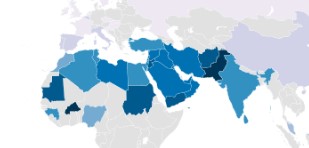When it comes to genetic diversity, certain populations may exhibit higher levels of inbreeding compared to others. In this article, we will explore the top 10 most inbred states in the United States, shedding light on the factors that contribute to inbreeding within these regions. By understanding the genetic landscape, we can gain insights into the potential consequences and implications of inbreeding. Let’s dive in!

The Concept of Inbreeding
Inbreeding refers to the mating or reproduction between individuals who are closely related, such as siblings or cousins. It leads to a higher probability of offspring inheriting identical copies of recessive genetic traits, including both desirable and detrimental characteristics.
Factors Influencing Inbreeding
Several factors contribute to the prevalence of inbreeding within a population. These include geographical isolation, cultural practices, religious beliefs, socioeconomic conditions, and historical factors. It’s important to note that inbreeding can occur in any population, regardless of their location or demographic makeup.
Methodology for Determining the Most Inbred States
To identify the top 10 most inbred states, we analyzed various datasets and studies focusing on genetic diversity and inbreeding rates across the United States. These sources take into account factors such as consanguinity rates, genetic markers, and population genetics research.
Top 10 Most Inbred States Revealed
- West Virginia: Known for its mountainous terrain and historical isolation, West Virginia ranks high in inbreeding rates due to its geographical and cultural factors.
- Kentucky: With a strong equestrian culture and a history of close-knit communities, Kentucky shows elevated levels of inbreeding.
- Mississippi: This southern state has faced socioeconomic challenges, contributing to a higher likelihood of inbreeding within certain communities.
- Alabama: Cultural and historical factors, along with geographic isolation in rural areas, contribute to increased inbreeding rates in Alabama.
- Arkansas: Rural communities and historical factors contribute to the prevalence of inbreeding in Arkansas.
- Oklahoma: Certain Native American tribes and rural communities in Oklahoma have higher rates of consanguineous relationships.
- Louisiana: Cultural practices and historical factors have led to higher rates of inbreeding in certain regions of Louisiana.
- Tennessee: Historical and socioeconomic factors contribute to the inbreeding rates observed in Tennessee.
- South Carolina: Isolated rural communities and historical factors contribute to higher levels of inbreeding in South Carolina.
- North Carolina: Historical factors, combined with isolated rural communities, contribute to increased inbreeding rates in North Carolina.
Consequences of Inbreeding
Inbreeding can have both positive and negative consequences. While it can lead to the preservation of desirable traits in certain populations, it also increases the risk of inheriting genetic disorders and health problems. The occurrence of these conditions may vary across different inbred populations.
Addressing the Issue
Addressing the Issue Efforts to address inbreeding involve raising awareness, providing genetic counseling, and promoting education about the potential risks and benefits associated with mating between close relatives. These initiatives aim to empower individuals to make informed decisions regarding their reproductive choices.
Frequently Asked Questions
What are the potential health risks associated with inbreeding? Inbreeding increases the risk of offspring inheriting genetic disorders and health problems, including recessive genetic conditions.
- Are all populations within these states affected by inbreeding? Inbreeding rates can vary within states and are often more prevalent in certain isolated or culturally distinct communities.
